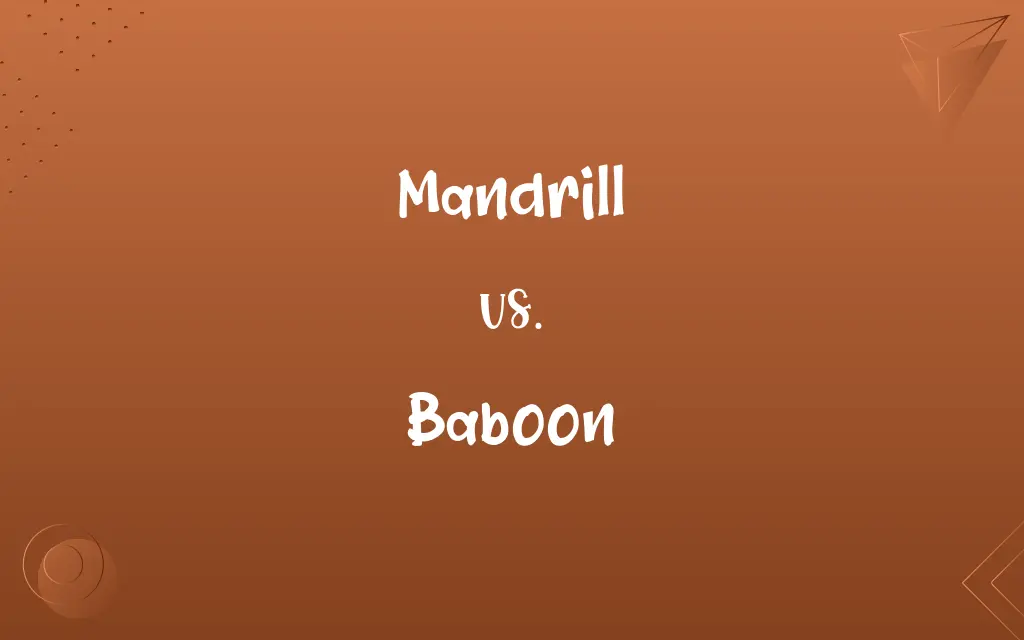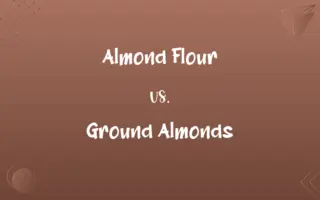Mandrill vs. Baboon: Know the Difference

By Shumaila Saeed || Published on January 5, 2024
Mandrills are vibrant, large monkeys known for their colorful faces, while baboons are more widespread, less colorful, and have distinctive snouts.

Key Differences
The Mandrill is recognized for its strikingly colorful face and buttocks, showcasing shades of blue, red, and pink, a feature especially prominent in males. The Baboon, conversely, is known for its distinctive dog-like snout and less colorful appearance, usually exhibiting a combination of brown, grey, and olive fur.
Shumaila Saeed
Jan 05, 2024
In terms of size, the Mandrill is one of the largest monkey species, with males significantly larger than females, exhibiting pronounced sexual dimorphism. Baboons are generally smaller compared to mandrills, and while they also display sexual dimorphism, it's less pronounced than in mandrills.
Shumaila Saeed
Jan 05, 2024
Mandrills primarily inhabit rainforests in equatorial Africa and are more reclusive in nature. Baboons, on the other hand, have a broader range, found in various African environments and even into the Arabian Peninsula, adapting to savannas, woodlands, and semi-arid regions.
Shumaila Saeed
Jan 05, 2024
The social structure of Mandrills is quite complex, often forming large groups known as hordes, which can include hundreds of individuals. Baboons form troops, which are usually smaller than mandrill hordes, but they exhibit a strong social structure characterized by a hierarchical system.
Shumaila Saeed
Jan 05, 2024
The diet of a Mandrill mainly consists of fruits, seeds, and invertebrates, and they are known to be more arboreal, spending a lot of time in trees. Baboons have a more varied diet that includes fruits, grasses, seeds, roots, and occasionally small mammals or birds, and they are more terrestrial, spending much of their time on the ground.
Shumaila Saeed
Jan 05, 2024
ADVERTISEMENT
Comparison Chart
Size and Dimorphism
One of the largest monkeys, strong dimorphism
Smaller, less pronounced dimorphism
Shumaila Saeed
Jan 05, 2024
Habitat
Rainforests in equatorial Africa
Savannas, woodlands, semi-arid regions
Shumaila Saeed
Jan 05, 2024
Social Structure
Large groups called hordes
Smaller troops with hierarchical system
Shumaila Saeed
Jan 05, 2024
Diet and Behavior
Fruits, seeds, more arboreal
Varied diet, more terrestrial
Shumaila Saeed
Jan 05, 2024
ADVERTISEMENT
Mandrill and Baboon Definitions
Mandrill
Mandrills are large, colorful monkeys native to African rainforests.
The mandrill's vibrant face makes it easily distinguishable in the dense forest.
Shumaila Saeed
Dec 28, 2023
Baboon
Baboons are adaptable, inhabiting diverse environments.
You can find baboons in various habitats, from savannas to woodlands.
Shumaila Saeed
Dec 28, 2023
Mandrill
Mandrills primarily consume fruits and invertebrates.
Mandrills in the wild spend much of their time foraging for fruits.
Shumaila Saeed
Dec 28, 2023
Baboon
Baboons are large monkeys with dog-like snouts.
The baboon's distinct snout sets it apart from other primates.
Shumaila Saeed
Dec 28, 2023
Mandrill
Mandrills exhibit significant sexual dimorphism.
Male mandrills are notably larger and more colorful than females.
Shumaila Saeed
Dec 28, 2023
ADVERTISEMENT
Baboon
Baboons have strong social structures within their troops.
The hierarchy in a baboon troop is clearly defined and maintained.
Shumaila Saeed
Dec 28, 2023
Mandrill
Mandrills are one of the largest monkey species.
The sheer size of the male mandrill is impressive compared to other monkeys.
Shumaila Saeed
Dec 28, 2023
Baboon
Baboons have a varied diet, including plants and animals.
Baboons often forage on the ground for roots, insects, and small mammals.
Shumaila Saeed
Dec 28, 2023
Mandrill
Mandrills are known for their complex social structures.
Observing the social interactions within a mandrill horde can be fascinating.
Shumaila Saeed
Dec 28, 2023
Baboon
Baboons are more terrestrial compared to other primates.
Unlike many primates, baboons spend a lot of their time on the ground.
Shumaila Saeed
Dec 28, 2023
Mandrill
A large terrestrial monkey (Mandrillus sphinx) of dense forests of west-central Africa, having an olive-brown body with a brightly colored rump and face that are especially pronounced in the male.
Shumaila Saeed
Dec 27, 2023
Baboon
Any of several large terrestrial African and Arabian monkeys of the genus Papio, having an elongated doglike muzzle and bare calluses on the buttocks.
Shumaila Saeed
Dec 27, 2023
Mandrill
A large West African baboon (Papio sphinx syn. Mandrillus sphinx, formerly Cynocephalus mormon syn. Papio mormon). The adult male has, on the sides of the nose, large, naked, grooved swellings, conspicuously striped with blue and red. It is an endangered species.
Shumaila Saeed
Dec 27, 2023
Baboon
An Old World monkey of the genus Papio, having dog-like muzzles and large canine teeth, cheek pouches, a short tail, and naked callosities on the buttocks. 13
Shumaila Saeed
Dec 27, 2023
Baboon
One of the Old World Quadrumana, of the genera Cynocephalus and Papio; the dog-faced ape. Baboons have dog-like muzzles and large canine teeth, cheek pouches, a short tail, and naked callosities on the buttocks. They are mostly African. See Mandrill, and Chacma, and Drill an ape.
Shumaila Saeed
Dec 27, 2023
Repeatedly Asked Queries
What is a Mandrill?
A large, colorful monkey native to African rainforests.
Shumaila Saeed
Jan 05, 2024
Can Baboons be aggressive?
Yes, especially when threatened or during social conflicts.
Shumaila Saeed
Jan 05, 2024
Do Baboons spend more time in trees or on the ground?
They are more terrestrial, spending time on the ground.
Shumaila Saeed
Jan 05, 2024
Is there sexual dimorphism in Mandrills?
Yes, males are larger and more colorful.
Shumaila Saeed
Jan 05, 2024
What's the lifespan of a Mandrill in the wild?
They can live up to 20 years.
Shumaila Saeed
Jan 05, 2024
How do Baboons interact with humans?
They can adapt to human presence but may become nuisances.
Shumaila Saeed
Jan 05, 2024
How do Baboons communicate?
Through vocalizations, body postures, and facial expressions.
Shumaila Saeed
Jan 05, 2024
Are Mandrills endangered?
They are vulnerable due to habitat loss and hunting.
Shumaila Saeed
Jan 05, 2024
What role do Baboons play in their ecosystem?
They are important for seed dispersal and as prey for larger predators.
Shumaila Saeed
Jan 05, 2024
Share this page
Link for your blog / website
HTML
Link to share via messenger
About Author
Written by
Shumaila SaeedShumaila Saeed, an expert content creator with 6 years of experience, specializes in distilling complex topics into easily digestible comparisons, shining a light on the nuances that both inform and educate readers with clarity and accuracy.









































































